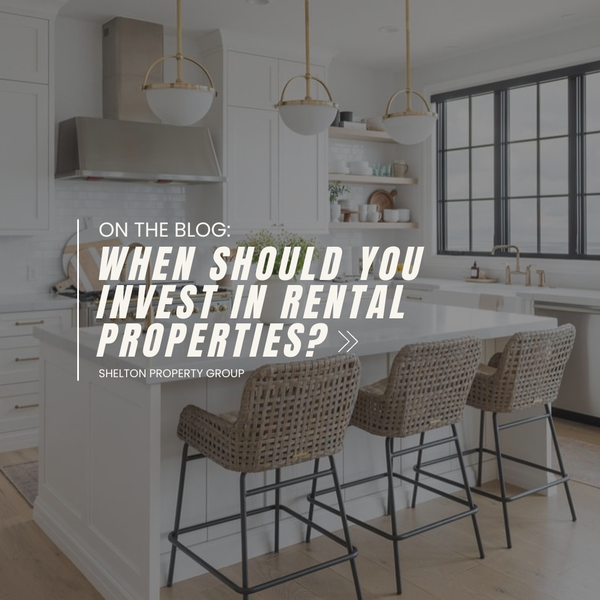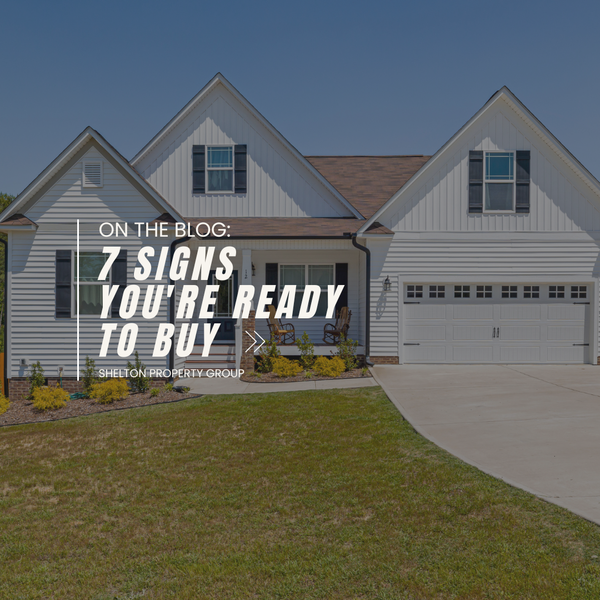When Should You Invest In Rental Properties?
If you are considering becoming a property investor, you may wonder why you should buy a rental and what indicators to look for when trying to find a property. Here are some signs to look for if you are on the fence about investing in a rental that indicate it is a great time to buy!
Low Interest Rates
When mortgage rates drop, it is much easier to make a property produce income. The best place to figure out what kind of interest rate you will get for an investment property is with a lender. Check in with them to figure out how to start the process, and contact an agent to help you start viewing potential properties.
Home Equity
Check in with a local Realtor to see how much your current home is worth! Some investment properties require a high down payment, but low-interest rates, refinancing and knowing your home value can make a difference. For example, if you need to borrow 10%, many homes in good markets can appreciate 10% of their value in just a year, depending on the condition and the location. Chat with a lender to see if you can qualify, and check in with your current mortgage company to discuss your plan.
Scarcity of Units
Do you live in a location where rental units are in high-demand? Maybe your city is growing and the demand for a space to rent is higher than the available properties. If that is the case, now is the best time to find a property to purchase for rental purposes.
Return Rate
If the rate of return in your county is growing, it might be a good time to invest in property. If there is a yearly increase, you can make significant gains over time.
Ultimately, talking to professionals can help you decide if now is the right time to invest in rental properties!
7 Signs You're Ready To Buy
Living in an apartment or rental home does have its perks: You can test out different neighborhoods and locations, you have the flexibility to move, and you have access to great amenities like a gym or pool. But there’s a reason that owning a home, rather than renting one, is a highly desired achievement.
Maybe the thought of having your own place has crossed your mind only recently, or maybe you’re regularly saving a chunk of your paycheck for that future down payment. No matter where you are in the process of considering homeownership, here are the unmistakable signs that you’re ready to buy your first home.
1. You Want to Get to Know Your Neighbors
Because renters don’t tend to live in one apartment for very long, it can be difficult to meet people who live in your building. But when you buy a home and are more invested in your community, it’s easier to forge lasting friendships.
2. You Want to Customize Your Space
Many rental communities have limits on what you can customize in your unit. You may be able to paint your walls a different color, but you may not be able to replace the countertops or appliances that come standard in your apartment.
3. You Want More Space or Amenities
You daydream about having a home with a large kitchen, dining room, basement, garage, or maybe even a home office or bonus room for your hobbies.
4. You Regularly Drive by Your Favorite Neighborhoods
You have a list of at least three communities (or maybe even houses) that you would love to live in when you’re ready to buy a home. You might even attend an open house or two.
5. You’re Eager to Put Down Roots
A home is more than a financial investment. It’s your own space, a private retreat, and the start of a new chapter in your life. You’ll love being able to make lasting memories with your new neighbors and enjoying all the amenities near your home.
6. You’re Constantly Browsing Home Improvement Sites
Instead of scrolling through social media, you’re scrolling through home decor websites or binge-watching HGTV. You now have dozens of ideas for how you’re going to decorate everything from the bathrooms to the entryway.
7. You Have Money Saved Up for a Down Payment
A down payment is essential to buying the home of your dreams. But once you see your savings account grow, you know your new home is just within reach.
7 Ways to Compete in a Sellers Market
Buying a home is a team sport, and that’s especially true when buyers are facing the kinds of affordability challenges they are now. Volatile interest rates and tough competition for a limited supply of homes are posing unique issues for home shoppers. If you've been writing offer after offer — even competitive offers over asking price — and still not getting anywhere, then it could be time to change tactics.
Strategies tied to mortgage products and seller incentives can help buyers, even in situations involving cash buyers or shoppers offering above list price. These tactics won’t apply to every situation, but they offer buyers an idea about the kinds of adjustments to their offers or financing that can make the difference between getting the keys or attending yet another open house. It is important to note that every real estate market and buyer/seller transaction is unique and results may vary.
1. Offer a partial appraisal waiverAn appraisal establishes the current value of a home, and is used by lenders to determine how much they’re willing to lend buyers for a given home. Buyers who make an offer on a house usually include an appraisal contingency that lets them cancel the deal without a penalty if the house doesn’t appraise for the agreed-upon price.
Buyers in competitive markets can be tempted to waive appraisals, but doing so could require them to bring more money to the table at closing if there’s a gap between the price they offered on a home and what an expert appraiser thinks it’s worth. This is because a mortgage is tied to what the appraiser determines the home is worth. Anything over that amount is the buyer’s upfront responsibility.
Instead of waiving an appraisal altogether, some clients agree to pay a specified amount over the negotiated sales price if there’s a gap between the asking price and the appraised value. That way, the buyer can still write a competitive offer, but not to the point of putting themselves at risk of having to come to the table with a big check — or losing their earnest money.
2. Show sellers you’re serious with a “time off market” feeIn a market where it's common for buyers to lose a home to a competitor who is offering over asking price, there’s an option that could, in some cases, be just as attractive to sellers and potentially less expensive. It's called a time off market fee.
When buyers make an offer on a home, they typically put up earnest money — a relatively small amount that can be refunded if certain conditions aren’t met.
With a “time off market” fee or TOM, however, the seller keeps the money regardless of whether the deal closes. It’s paid to them for accepting the buyers’ offer. It’s a bold strategy and it works really well. If the buyer doesn’t close, they still have to pay that money.
A TOM fee in place of earnest money, can be more attractive to a seller than an offer over the asking price, especially if the offer would result in an appraisal gap, where the sales price is more than what an appraiser determines a house is worth in the current market.
For instance, a real estate agent negotiated a deal where a competing offer was about $10,000 over the listing price. Rather than match that offer, they successfully made a case that the house was accurately priced based on the sale of comparable homes; an offer above that price would inevitably result in an appraisal gap that could jeopardize the deal.
This competitive offer strategy can be more attractive to the seller, and ultimately cheaper for the buyer, than making an offer $10,000 over asking.
The size of the TOM fee depends on the price of the house, but usually it has ranged from $500 to $5,000 plus. The buyer has to understand what a TOM fee is and be 100% comfortable with it and be committed to that house or willing to lose that TOM fee in the event they don’t close on it.
3. Pay a lender for a lower interest rate over the life of the loanBuying “mortgage points,” also known as discount points or simply points, from a lender can help reduce the monthly payment on a home. Mortgage points are essentially prepaid interest that is paid at closing in exchange for a lower interest rate over the life of the loan. Each point typically costs 1% of the total loan amount. The more points you buy, the lower the interest rate.
One point generally reduces the interest rate by a specific percentage, often 0.25%. For example, if a buyer applies for a $300,000 mortgage and decides to buy one point, they would pay $3,000 (1% of $300,000) and receive a reduction of 0.25% on their interest rate.
Buyers considering this strategy should consider how long they plan to stay in the home, how much they’ll save by reducing the interest rate and how much money they’ll have to spend upfront. A loan officer or financial advisor can help determine whether buying points makes sense for you.
4. Pay a lender to temporarily lower your interest rateAnother way to lower a monthly mortgage payment is to cut the interest rate for the first one to three years of the loan. The most common mortgage product to do that is a 2/1 buydown. It allows a borrower to 'buy' a lower interest rate for the first two years of their mortgage by prepaying a portion of the interest on the loan. For example, a borrower who applies for a 30-year, fixed rate mortgage at 7% can lower the mortgage to 5% the first year and 6% the second year by pre-paying the interest they would have paid at the 7% rate for those two years. The mortgage then reverts to 7% in the third year.
It's important to note that the buydown cost is separate from other closing costs, and can be paid for by the seller, builder or buyer. Buyers who adopt this strategy either plan on interest rates dropping so they can refinance or on their incomes increasing over the two years that the lower rate is in effect.
Loan officers can provide accurate and up-to-date information on the cost of a 2/1 buydown, and provide specific details based on different loan amounts, interest rates and loan terms.
5. Bump up the offer price in exchange for a lower, seller-subsidized mortgage rateThis tactic is most effective when negotiating with a seller whose house is not selling as quickly as expected or when the market favors buyers.
Example: Offering about $8,000 over list price and asking the seller to credit that money back so the buyer can purchase a lower mortgage interest rate from their lender at closing.
In effect, the buyer increased the loan amount so they didn’t have to pay out-of-pocket to get a lower rate. The result: a lower monthly payment and the ability to spread the cost of the buydown over the life of the loan.
There’s a risk if it doesn’t appraise at the higher amount, but if you can use that money for a 2/1 buydown, or just buy the rate down by a certain percentage point, you can lower the monthly payment.
The 2/1 buydown temporarily lowers the mortgage payment for two years while buying points lowers payments over the life of the loan.
In the mentioned example the client was able to buy down the mortgage rate by 1.5 percentage points, putting them in a better position on their mortgage payments than if they’d paid the listing price without the lower interest rate.
6. Ask for a lender credit to buy down the mortgage rateThis is where professional relationships are especially important. Agents who work closely with lender partners can help buyers make a better, more competitive offer in neck-in-neck situations, he says.
While some of these scenarios may seem complicated, an experienced agent and loan officer can talk through options. Buyers who want to explore different scenarios can do so with the many resources available.
7. Consider new constructionWhile buying new construction isn’t a competitive offer strategy, it provides one avenue for more affordable mortgage rates. The added bonus: in certain markets there is less competition, no bidding wars and clients get a brand new home. A lot of builders offer great incentives with in-house financing, such as a 4.99% interest on financing. The rate was about 2% lower than the rates on a 30-year mortgage.
While builders might hold firm on the asking price so as not to affect prices on homes in the rest of the development, they may be more willing to negotiate around concessions and financing.
Whether you’re in the hunt for a home or you’re still in the dreaming phase, it can help to familiarize yourself with strategies on making competitive offers in a sellers market, so that when the time is right, you know your options — be sure to talk to your agent to know for sure. Every tactic comes with some degree of risk, and it’s critical that buyers understand tradeoffs and consequences and how the tactics fit into the bigger picture.

Emily Shelton
Phone:+1(512) 924-3233




